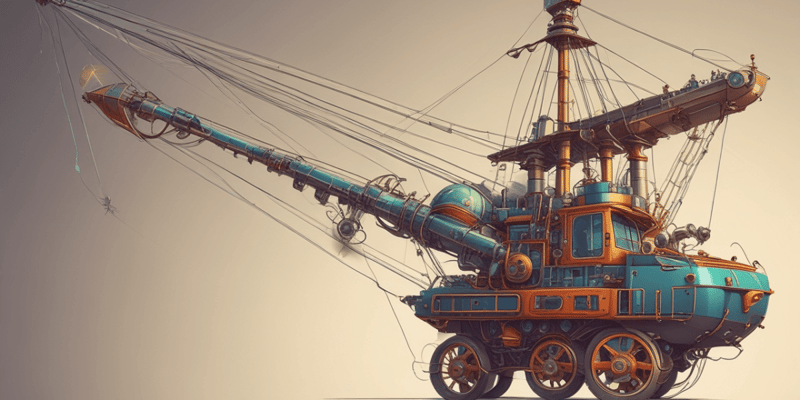10 Questions
What is the function of a simple machine?
To change the direction, magnitude, or velocity of a force
Which type of lever has the effort arm greater than the load arm?
Class 1 lever
What is the main function of inclined planes?
To change the direction of a force
What type of energy is converted into kinetic energy when an object is rolled down an inclined plane?
Gravitational energy
Which of the following is NOT a type of simple machine?
Accelerator
Which simple machine is used to change the direction of a force by attaching a rope or cable?
Pulley
How does a wheel and axle increase the mechanical advantage of a force?
By decreasing the force required
What type of force does a screw convert into linear force?
Rotational force
Which simple machine increases the force applied to an object by concentrating it?
Wedge
What is the role of simple machines in our daily lives, according to the text?
They make work easier, more efficient, and more effective.
Study Notes
Title: Unraveling the Wonders of Science: Exploring Simple Machines
Introduction
Science, a vast and ever-expanding field, encompasses a multitude of disciplines that aim to understand the world around us. One aspect of science that captivates our curiosity and serves as a fundamental building block for technological advancements is the study of simple machines. In this article, we will delve into the fascinating realm of simple machines, uncovering their history, operation, and everyday applications.
Definition of a Simple Machine
A simple machine is a basic device that changes the direction, magnitude, or velocity of a force without undergoing any substantial change in its energy. These devices contain few moving parts and are designed to make work easier, more efficient, or more effective. Simple machines include the lever, inclined plane, pulley, wheel and axle, screw, and wedge.
Levers
The lever is a simple machine that converts a smaller force into a larger force or a larger distance. Levers come in three types: Class 1 lever (effort arm is greater than the load arm, e.g., a seesaw), Class 2 lever (effort arm is less than the load arm, e.g., a wheelbarrow), and Class 3 lever (effort arm and load arm are equal, e.g., a balance scale). Levers are used in our daily lives, from opening a door to lifting heavy objects.
Inclined Planes
Inclined planes, or ramps, are simple machines that change the direction of a force by reducing its magnitude. If an object is rolled down an inclined plane, gravitational energy is converted into kinetic energy. Conversely, when an object is pulled up an inclined plane, potential energy is converted into kinetic energy. Inclined planes make it easier to lift heavy objects, like ramps used on loading docks or inclines on a staircase.
Pulleys
Pulleys are wheels that have a groove around their circumference. By attaching a rope or cable, pulleys can change the direction of a force. Pulleys are often used in conjunction with other simple machines, like ropes and levers, to amplify force and make lifting easier. Moreover, pulleys can be combined to form more complex systems, like the block and tackle system.
Wheels and Axles
A wheel and axle is a simple machine that increases the mechanical advantage of a force. By wrapping a rope or cable around the wheel, it can be rotated with a smaller force than would be needed if the wheel were not present. A bicycle's chainring and cassette are examples of wheels and axles.
Screws
Screws are simple machines that convert rotational force into linear force. By turning a screwdriver in a clockwise direction, the threads of a screw pull or push an object toward the screw head. Screws are used in construction and in fastening objects together, like boards or a desk top.
Wedges
Wedges are simple machines that increase the force applied to an object by concentrating it. A wedge, like a knife or an axe, cuts through an object by separating it along a particular plane. Wedges are used to separate stones, split logs, or even open bottles.
Everyday Applications
Simple machines are used in our daily lives, often without our conscious recognition. From the humble doorknob to the most complex mechanical devices, simple machines are the cornerstones of engineering. Simple machines make work easier, more efficient, and more effective. They save time, energy, and resources, and continue to be the foundation of technological advancement.
Conclusion
The study of simple machines is a fascinating journey into the history, operation, and everyday applications of these fundamental devices. Simple machines are at the heart of our world, from the smallest hand-held gadgets to the largest construction projects. By understanding the principles behind simple machines, we can appreciate the ingenuity of the human mind and its ability to solve the complex problems faced by our society.
Test your knowledge about simple machines with this quiz that covers the history, operation, and everyday applications of levers, inclined planes, pulleys, wheels and axles, screws, and wedges. Explore the fascinating realm of simple machines and uncover their impact on technological advancements.
Make Your Own Quizzes and Flashcards
Convert your notes into interactive study material.




